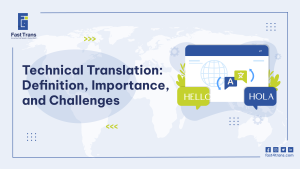Cognitive debriefing in Arabic translation ensures that surveys and medical documents are clear, culturally relevant, and easily understood by diverse Arabic-speaking audiences. By interviewing participants and analyzing their responses, this process identifies ambiguities, refines linguistic accuracy, and enhances the reliability of research data.
As a vital step in linguistic validation, it bridges cultural and linguistic gaps, allowing for precise patient-reported outcomes and clinical assessments. Ultimately, it guarantees that Arabic translations are not just accurate but also resonate with the intended audience, fostering better communication and more meaningful research results.
What Is Cognitive Debriefing in Arabic Translation?
Cognitive debriefing is a crucial part of the linguistic validation process (we will explore what that means in a minute). It ensures that a translated survey or document is cognitively understood by Arabic-speaking individuals from different demographics.
This qualitative research technique is commonly used in the development and validation of patient-reported outcome (PRO) measures, such as questionnaires or surveys. It involves interviewing Arabic-speaking participants who have completed the measure to analyze their thought processes while responding to the questions.
Goal of Cognitive Debriefing in Arabic Translation
- Ensuring that Arabic-speaking recipients face no difficulty or ambiguity in understanding the survey.
- Maintaining the same context, meaning, and comprehension in both the source and Arabic translation.
- Adapting the document/survey to be culturally relevant for Arabic-speaking audiences.
- Identifying terms that may be confusing or culturally inappropriate for Arabic readers.
- Resolving any interpretation issues specific to Arabic linguistic structures.
We mentioned linguistic validation—so, what is it, and how does it differ from cognitive debriefing?
Linguistic Validation in Arabic Translation
Linguistic validation is a meticulous process that adheres to the standards of the International Society for Pharmacoeconomics & Outcomes Research (ISPOR) and the Food & Drug Administration (FDA).
In Arabic translation, this process ensures that the translated text remains highly faithful to the original while accurately conveying its meaning without ambiguity, considering the linguistic complexities and dialectical variations in Arabic.
Goals of Linguistic Validation in Arabic Translation
- Ensuring that the Arabic translation accurately reflects the source text.
- Making the translation culturally appropriate for Arabic-speaking audiences.
- Confirming that the intended Arabic-speaking population fully understands the text.
- Finding precise Arabic equivalents for words or concepts that may not directly exist in the language.
Linguistic validation is a comprehensive process, with cognitive debriefing being one essential step. Other steps include back translation and reconciliation, both of which further refine the accuracy of the Arabic translation.
Read more: Difference between In house, Outsource, and Freelance translators
Importance of Cognitive Debriefing in Arabic Translation
We all know that medical translation is one of the most sensitive types of translation out there, especially when dealing with Arabic. There is no room for errors or ambiguities because the risk is too high.
This is where the importance of cognitive debriefing in Arabic translation comes in; it aids in collecting information for several medical purposes like research studies, experiments, clinical trials, interviews, and plenty of other medical purposes. It ensures that translations into Arabic are as accurate as possible, free from linguistic errors, and culturally appropriate. It helps remove language and cultural barriers that might otherwise hinder understanding, particularly given the linguistic diversity across Arabic-speaking regions.
The bigger picture of cognitive debriefing in Arabic translation is assisting research to reach more accurate and realistic results. Simply, when Arabic-speaking patients answer a survey with full understanding of the subject matter and what it aims to communicate, they provide more precise and reliable responses—ultimately pushing the research forward in the right direction.
The Main Purpose of Cognitive Debriefing
Making medical surveys accessible to different demographics (age, gender, race, language, ethnicity…)
Linguists and researchers do their best to find any errors or possibilities for improvement in the translation of these surveys before they officially use them in their research process.
Improvement of questionnaire translation based on the feedback of the participants.
Examples of Cognitive Debriefing
Examples of cognitive assessment in healthcare include self-reported health metrics (like pain levels), clinician-identified symptoms requiring medical judgment, third-party observations from caregivers on behavioral changes, and overall life quality evaluations based on physical, mental, and social well-being.
1. Patient Reported Outcomes (PROs)
When the patient himself reports symptoms of their health, like the measure of pain they are feeling.
2. Clinician Reported Outcomes (ClinROs)
It refers to symptoms that are clinically identified and measured. It could be noticeable changes in their quality of life that require medical judgment.
3. Observer Reported Outcomes (ObsROs)
When someone other than the patient or their doctor (maybe a parent, or a partner) reports symptoms about them; like sudden changes in behaviors, or worrisome behaviors like vomiting, having nightmares, or self-harming…etc.
4. Quality of Life (QOL)
When measuring an individual’s quality of life, medical professionals look at things like physical and mental well-being, education, social status…etc.
You can check NIH’s definition of PROs, ClinRo, ObsRO, and QoL for more insight.
General Steps Involved With Cognitive Debriefing in Arabic Translation
Arabic translation validation involves a structured assessment to ensure clarity and cultural relevance. Experts, ideally native Arabic-speaking professionals with healthcare expertise, conduct interviews to gauge comprehension, using diverse participants for accuracy. The process includes preparation, real-life testing, data analysis, and summarization to refine translations and enhance linguistic precision.
1. Preparation
Before interviewers conduct cognitive debriefing in Arabic translation, they should have a clear understanding of the questions. Researchers guide them on which questions to ask and outline the entire procedure.
For interviews conducted in Arabic-speaking countries, it is best to hire native Arabic-speaking psychologists or social workers who are familiar with the cultural and linguistic nuances of the target population. This ensures effective communication with native Arabic-speaking patients or subjects. Ideally, interviewers should also have a background in the healthcare field to better understand the context of the translated materials.
This process includes training the interviewers to ensure they are well-prepared for conducting cognitive debriefing with the Arabic-speaking target population. The role requires not only language proficiency but also social skills, such as recognizing the interviewee’s emotions and body language during the questionnaire. More importantly, interviewers must know how to ask the right questions in a culturally appropriate manner.
2. Deciding Who to Interview in a Cognitive Debriefing
Participant diversity is crucial. The interview process should aim to include individuals from various demographics, such as different age groups, genders, and social backgrounds, depending on the research objectives. Ensuring a diverse sample allows for a more accurate assessment of the Arabic translation’s clarity and effectiveness.
3. Interviewing
The final step is to implement the process in real-life settings.
Following the protocol established in the preparation and training phases, interviews take place in person. During these interviews, participants provide feedback on how they perceive and understand the translated content. They indicate whether any terms or phrases in the Arabic translation are unclear or ambiguous.
Interviewers document important findings, including responses, areas of confusion, and inconsistencies in reactions, all of which contribute to assessing the quality and effectiveness of the translation.
4. Harmonization of Cognitive Debriefing
At this stage, researchers analyze the collected data to ensure its validity and completeness. They address key questions such as:
- Is the information obtained from cognitive debriefing sufficient for evaluating the Arabic translation?
- Is further linguistic validation or cognitive debriefing required?
- Should the survey be retranslated to improve accuracy and comprehension?
5. Summarizing Results of Debriefing
The purpose of summarization is to ensure that all stakeholders, including translators, researchers, project managers, and linguists, are aligned.
A summary report is prepared to document the entire cognitive debriefing process and its outcomes. The report includes key demographic details of participants, such as age and medical conditions, along with other relevant information, including:
- The number of participants involved
- Their age distribution
- The level of difficulty they faced in completing the survey
- The time required to complete the survey
- Challenges encountered in understanding or answering the questions
- Recommendations or solutions for improving the Arabic translation
Best Practices for Conducting Cognitive Debriefing in Arabic Translation
The process of cognitive debriefing in Arabic translation requires a variety of skills and best practices to help translators and research experts achieve the best outcome from available resources. Below are the most important practices to follow:
1. Participants Variety
It is essential to select participants who accurately represent the Arabic-speaking target audience. This means including individuals from different age groups, medical backgrounds, social statuses, and education levels to ensure comprehensive feedback.
2. Relaxed Interview Environment
This aspect is crucial for obtaining honest and insightful responses. Participants should feel comfortable expressing their thoughts about the Arabic translation without feeling pressured or rushed.
Given the cultural sensitivity in Arabic-speaking communities, interviewers must be empathetic when discussing delicate topics. If a participant shows discomfort or hesitation, the interviewer should provide reassurance and create a supportive atmosphere to encourage open communication.
3. Ask Open-ended Questions
Using only yes-or-no questions limits the depth of feedback participants can provide. Skilled interviewers should ask open-ended questions to allow participants to share their thoughts freely, ensuring clarity and accuracy in the Arabic translation. This technique, also known as the “think aloud” method, helps uncover any potential misinterpretations or ambiguities in the translated content.
Read more: How to choose the right language service provider?
Fast Trans Linguistic Validation Services is the best
Fast Trans is a leading translation company in the MENA region. We set the gold standard for accuracy and efficiency by hiring certified translators who can get you the best of two worlds; translation quality and second-to-thing price.
We offer 20+ kinds of translation services. When it comes to linguistic validation we make sure to hire linguists who have a solid background in the medical and healthcare field. In short. We know what it takes to provide impeccable linguistic validation services that shortcuts your research process and get you closer to accurate results!
Looking for quality linguistic validation services? You’ve come to the right place.
Conclusion
Cognitive debriefing in Arabic translation is an essential process that ensures surveys and documents are clearly understood by Arabic-speaking audiences from diverse backgrounds. This method, widely used in medical and research fields, involves interviewing participants to assess their comprehension of translated materials. It helps refine translations by identifying ambiguous or culturally inappropriate terms, ensuring that the Arabic version retains the meaning and intent of the original text. By addressing linguistic and cultural nuances, this approach enhances the accuracy and reliability of data collected from Arabic-speaking individuals.
As part of a broader linguistic validation framework, cognitive debriefing plays a critical role in improving medical and research translations. It helps eliminate misinterpretations that could impact the quality of patient-reported outcomes, clinical assessments, or quality-of-life measurements. The process involves multiple stages, including selecting diverse participants, conducting structured interviews, and analyzing feedback to refine the translation. Ultimately, cognitive debriefing ensures that Arabic-speaking respondents can engage with translated content without confusion, allowing for more precise and actionable research findings.











